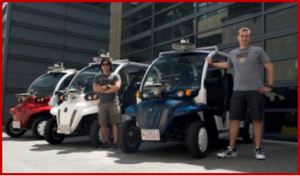
Graduate student Justin Miller and undergrad Wally Wibowo of the Aerospace Controls Lab working on vehicles with sensors that match those of autonomous vehicles. This is part of a Ford-MIT project to predict pedestrian behaviors while providing data to support a mobility-on-demand system for the MIT campus.
Ford Motor Company and the Massachusetts Institute of Technology are working on a research project that measures how pedestrians move in urban areas to improve public transportation, such as ride-hailing and point-to-point electric shuttles.
The MIT project is one of more than 30 research projects between Ford and universities in the U.S., Germany and China aimed at helping the company and academic world understand how to improve mobility for millions of people globally.
The project will introduce a fleet of on-demand electric shuttles that operate on both city roads and campus walkways on the university’s Cambridge, Massachusetts, campus. The vehicles use LiDAR sensors and cameras to measure pedestrian flow, which ultimately helps predict demand for the shuttles. This, in turn, helps researchers and drivers route electric shuttles toward areas with the highest demand.
“This helps us develop efficient algorithms that bring together relevant data. It improves mobility-on-demand services, and aids ongoing pedestrian detection and mapping efforts for autonomous vehicle research,” said Ken Washington, vice president of Research and Advanced Engineering at Ford.
The MIT research is being conducted by the Aeronautics and Astronautics Department’s Aerospace Controls Lab. ACL researches topics related to autonomous systems and control design for aircraft, spacecraft, and ground vehicles. Theoretical and experimental research is pursued in such areas as estimation and navigation, planning and learning under uncertainty, and vehicle autonomy.
Dynamic Shuttle
This collaboration is an extension of Ford’s Dynamic Shuttle project, which provides point-to-point shuttle rides to employees requesting rides using a mobile application on its Dearborn, Michigan, campus. The collaboration advances the ride-hailing concept by examining the movement of pedestrians to predict demand and reduce wait times for shuttles.
The algorithms and methods learned when navigating crowded pedestrian areas using LiDAR could strengthen Ford’s autonomous and driver assist technologies as the company continues develop autonomous vehicles.
The project is one of more than 30 mobility solutions university research projects between Ford and universities in the U.S., Germany and China aimed at helping the company and academic world understand how to improve mobility for millions of people globally.

